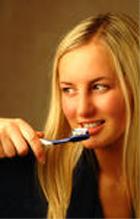
This section of our cosmetic dentistry information site provides you with some background into dental veneers, both composite veneers and porcelain veneers. Dental veneers, sometimes called tooth veneers, can be used to correct both color and shape problems. Teeth enamel discoloration can be caused by staining, aging, or chemical damage to teeth. Some of the more common causes of teeth discoloration are medications, coffee, tea or cigarettes. People who drink significant amounts of cola soft drinks can experience similar staining. While no alternative to veneers will create the exact same effect, there are some popular procedures that may seem worthwhile. Crowns, while more expensive, also act to cover the tooth with a protective coating. For individuals who simply want to brighten their teeth, many clinics now offer tooth bleaching, though this is a much less permanent procedure. The classic metal orthodontic braces are the most familiar method of teeth straightening. Consisting of a bracket glued to the front of each tooth and a metal wire connecting them, orthodontic braces usually require several years of wear for effective teeth straightening. They can be uncomfortable, expensive, and embarrassing for older patients. However, they are still the most effective method of teeth straightening and can correct overbites and underbites as well as individual teeth alignment. Tooth reshaping, or contouring, is one of few instant treatments now available in cosmetic dentistry. Dental reshaping and contouring is a procedure to correct crooked teeth, chipped teeth, cracked teeth or even overlapping teeth in just one session.
read article...
|

Orgasm disorders are a persistent delay or absence of orgasm following a normal sexual excitement phase. The disorder can occur in both women and men. Again, the SSRI antidepressants are frequent culprits -- these can delay the achievement of orgasm or eliminate it entirely. Erectile dysfunction, also called impotence, means that a man's penis doesn't get hard enough to have intercourse. The man cannot get or maintain an erection. This condition affects approximately 30 million men in the United States. Erectile dysfunction is not the same as premature ejaculation, the inability to ejaculate (retarded ejaculation) or infertility.) Abnormal levels of certain hormones, such as testosterone, thyroid hormone and a pituitary hormone known as prolactin, can interfere with erections and sex drive (libido). This is an uncommon cause of erectile dysfunction. Little is known about how to prevent erectile dysfunction. However, avoiding cigarette smoking and maintaining normal blood pressure and cholesterol levels can help because smoking and high cholesterol can affect blood vessels. Men with diabetes should strive to keep blood sugar levels under control. Because certain medications have been associated with erectile dysfunction, ask your doctor about possible side effects before you start using any new prescription.
read article...
|

Both fear and anxiety send signals through the body that prepare all systems for possible danger. Hormones, such as adrenaline and catecholamine, are released in what is known as the "fight or flight" response. The sudden increase in hormone levels speeds up the heart and increases the amount of blood being pumped. At the same time, the muscles tighten, increasing the individual's ability to fight or flee from danger. The intensity of these physiological responses varies according to the seriousness of the event or thought that sparked the emotion, the strength of the individual's fear or anxiety, and his or her previous experience and genetic makeup. As long as there's a good reason for fear or anxiety, and it doesn't interfere with the ability to work, play, and socialize, it is not considered a problem. But when anxiety takes on a life of its own and begins to disrupt everyday activities, the situation is no longer normal. A genuine emotional disorder is now at work... and it's time to see a doctor. Faced by a threat, your body responds with a complex cascade of chemicals. The hypothalamus, alerted by the brain, pumps out a specialized hormone that ultimately prompts the two adrenal glands (perched atop the kidneys) to release the energizing hormone known as adrenaline. The result--faster pulse, higher blood pressure, sharpened awareness--is the "fight or flight" response to fear and anxiety. Each anxiety disorder has its own distinct features, but they are all bound together by the common theme of excessive, irrational fear and dread. Medication is most helpful when there is clear disorder or, sometimes, a specific target symptom for a particular drug. Usually, a pattern of symptoms point to a specific chemical imbalance. Whenever an imbalance appears evident through a person's disordered behavior and emotional state, medication centers on modifying the strength of the signal or readjusting the balance among them.
read article...
|
Read our other articles:
|